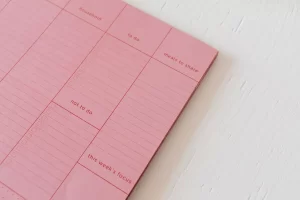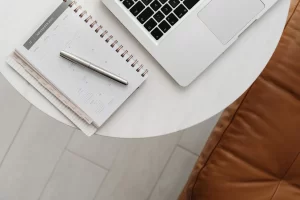So, what exactly makes a website “aesthetic”? Well, it’s not just about looking pretty (though that’s definitely part of it!). An aesthetic website is one that’s visually appealing, yes, but it also needs to be intuitive, engaging, and aligned with your brand identity. It’s about creating a digital space that not only catches the eye but also keeps visitors around and encourages them to take action.
Now, you might be wondering, “Roxie, why should I care about how to design an aesthetic website? Isn’t functionality more important?” Great question! Here’s the thing: your website is often the first impression potential customers have of your business. A well-designed, aesthetic website can:
- Build trust and credibility
- Keep visitors on your site longer
- Make your content more digestible
- Encourage conversions (whether that’s sales, sign-ups, or whatever your goal is)
- Set you apart from your competition
Pretty important stuff, right?
But don’t worry if the idea of designing an aesthetic website feels overwhelming. I’m here to break it down for you into manageable, actionable steps. In this guide, we’ll walk through everything from choosing the perfect color palette to creating intuitive navigation. We’ll talk about typography, layout, imagery, and even those cool little animations that make your site feel extra special.
Start with a clear purpose
When you’re figuring out how to design an aesthetic website, it’s tempting to jump right into choosing pretty colors or cool fonts. But hold up! Before we get to the fun visual stuff, we need to lay some groundwork.
The first step in how to design an aesthetic website is to define your purpose. Ask yourself:
- What’s the main goal of my website? Is it to sell products, share information, build a community, or something else?
- Who’s my target audience? What are their needs, preferences, and pain points?
- What action do I want visitors to take when they land on my site?
These questions might seem basic, but trust me, they’re crucial. Your answers will guide every design decision you make moving forward.
For example, if you’re creating a website for a yoga studio aimed at busy professionals, your aesthetic choices will be very different from a site for a high-energy fitness boot camp. The yoga site might use calming colors and plenty of white space to convey tranquility, while the boot camp site could use bold, high-contrast designs to convey intensity.
Remember, aesthetics isn’t just about looking good—it’s about effectively communicating your message and brand. So when you’re planning how to design an aesthetic website, always start with your purpose.
Pro tip: Write down your website’s purpose and keep it visible as you design. It’ll help you stay focused and make decisions that align with your goals.
Choose a cohesive color palette
Choosing the right color palette is a very important step in how to design an aesthetic website. Colors can evoke emotions, guide users’ attention, and reinforce your brand identity. So, how do we pick the perfect palette?
When learning how to design an aesthetic website, remember that your color choices should always tie back to your purpose and target audience. Here’s a quick guide to get you started:
- Start with your brand colors: If you already have a logo or brand guide, use those colors as a starting point.
- Understand color psychology: Different colors evoke different emotions. For example, blue conveys trust and professionalism, while orange represents energy and creativity.
- Use the 60-30-10 rule: Choose a dominant color for 60% of your design, a secondary color for 30%, and an accent color for 10%. This creates a balanced, harmonious look.
- Don’t forget accessibility: Make sure there’s enough contrast between your text and background colors for easy readability.
- Test your palette: Try your colors in different combinations and on various elements of your site to see how they work together.
Remember, learning how to design an aesthetic website is all about balance. You want your color palette to be engaging without being overwhelming.
Pro tip: Stuck on choosing colors? Nature is a great inspiration! Take a photo of a landscape or object you find beautiful and use a color picker tool to extract a palette from it. Or get inspired by these 40+ feminine color palette examples!
Tools like Adobe Color, Coolors, or Canva‘s color palette generator can be super helpful in creating harmonious color schemes. Play around with them and see what speaks to you and your brand!
Typography matters
When it comes to how to design an aesthetic website, typography is like the voice of your design. It’s not just about what you say, but how you say it visually.
If you’re figuring out how to design an aesthetic website, remember that good typography can:
- Set the tone for your entire site
- Guide users through your content
- Reinforce your brand personality
- Improve readability and user experience
Here’s a quick guide to nailing your typography:
- Choose fonts that fit your brand: Just like with colors, your font choices should align with your brand personality. A sleek sans-serif might be perfect for a tech startup, while an elegant serif could work well for a luxury brand.
- Limit your selection: When it comes to fonts, less is often more. Stick to 2-3 fonts max for a cohesive look.
- Create a hierarchy: Use different sizes, weights, and styles to guide users through your content. Your main headings, subheadings, and body text should be clearly distinguishable.
- Mind your spacing: Pay attention to line height, letter spacing, and paragraph spacing. Good spacing can dramatically improve readability.
- Test on different devices: Make sure your chosen fonts look good and remain readable on both desktop and mobile screens.
Remember, learning how to design an aesthetic website is about creating a harmonious overall look. Your typography should work in concert with your color palette and other design elements.
Pro tip: Pair a decorative font for headings with a simple, highly readable font for body text. This creates interest without sacrificing usability.
Don’t be afraid to experiment with different font combinations. Tools like Google Fonts, Adobe Fonts, or FontPair can be super helpful in finding complementary typefaces.
Create a consistent layout
When you’re learning how to design an aesthetic website, think of your layout as the skeleton of your design. It’s the invisible structure that holds everything together and guides your visitors’ eyes exactly where you want them to go.
A well-planned layout is important in how to design an aesthetic website because it:
- Creates a sense of order and professionalism
- Improves user navigation and flow
- Enhances readability and content absorption
- Ensures consistency across different pages
Let’s see how to create a layout that’ll make your website look aesthetic:
- Embrace the grid: Start with a grid system to align your elements. This creates a sense of order and makes your design feel intentional.
- Use the rule of thirds: Divide your layout into a 3×3 grid and place key elements along these lines or at their intersections. It’s a classic design principle that just works!
- Mind your white space: Don’t be afraid of empty space. It gives your content room to breathe and can make your design feel more luxurious and intentional.
- Create a visual hierarchy: Arrange elements by importance. Your most crucial information should be the most prominent.
- Maintain consistency: Use similar layouts across different pages. This helps users feel comfortable navigating your site.
Remember, when figuring out how to design an aesthetic website, your layout should support your content, not overshadow it.
Pro tip: Sketch out your layout on paper before diving into digital design. It’s a quick way to experiment with different arrangements without getting bogged down in details.
Tools like Figma, Sketch, or even good old Photoshop can help you create and refine your layouts. And don’t forget to check out some CSS grid tutorials if you’re coding your site yourself!
Use high-quality images and graphics
Picture this: you’ve nailed your color palette, your typography is on point, and your layout is pixel-perfect. But if your images are blurry or your graphics look amateur, all that hard work goes out the window. That’s why mastering the use of visuals is an important step in how to design an aesthetic website.
When you’re learning how to design an aesthetic website, remember that images and graphics can:
- Capture attention and draw users in
- Convey information quickly and effectively
- Evoke emotions and set the mood of your site
- Reinforce your brand identity
So this is how you can make your visuals stand out:
- Quality over quantity: It’s better to have a few stunning images than a bunch of mediocre ones. Invest in professional photography or high-quality stock images.
- Stay on brand: Choose images that align with your brand’s style and message. A luxury spa website probably shouldn’t feature grungy urban scenes, right?
- Optimize for the web: Large image files can slow down your site. Compress your images and use appropriate file formats (WEBP is the newest and best format).
- Use alt text: This helps with accessibility and SEO. Describe your images clearly but concisely.
- Consider custom graphics: Custom icons or illustrations can add a unique touch to your site and reinforce your brand identity.
Remember, figuring out how to design an aesthetic website is about creating a cohesive visual experience. Your images and graphics should complement your other design elements, not clash with them.
Pro tip: Create a mood board before you start designing. It’ll help you visualize how your images, graphics, and other design elements will work together.
Tools like Canva, Adobe Creative Suite, or even free options like GIMP can help you create and edit stunning visuals. And don’t forget about great stock photo sites like Unsplash or Pexels for high-quality, free images!
Implement thoughtful navigation
We’ve made our website look amazing, but what good is a beautiful site if users get lost in it? That’s why nailing your navigation is a big step in how to design an aesthetic website. Think of it as the map that guides visitors through your website.
When building your website you need to remember that good navigation:
- Helps users find what they’re looking for quickly
- Improves overall user experience
- Keeps visitors on your site longer
- Can reinforce your brand’s style and personality
Let’s navigate our way through some top tips (see what I did there? ;)):
- Keep it simple: Stick to clear, concise labels for your menu items. No need to get fancy here – clarity is key.
- Use hierarchy: Organize your menu items by importance. Your most crucial pages should be the easiest to find.
- Stick to conventions: Users expect to find certain elements in certain places. For example, your logo in the top left corner typically links to the homepage.
- Make it visible: Your main navigation should be easy to spot on every page. Sticky headers can work wonders here.
- Consider mobile: Don’t forget about your mobile users! A hamburger menu or bottom navigation bar can work well for smaller screens.
Remember, learning how to design an aesthetic website isn’t just about looks – it’s about creating a seamless user experience. Your navigation should be both functional and visually pleasing.
Pro tip: Use hover effects or subtle animations to make your navigation interactive and engaging. Just don’t go overboard – the goal is to enhance, not distract.
Tools like Figma or Adobe XD are great for prototyping your navigation and testing different layouts. And don’t be afraid to look at other websites for inspiration – just make sure to put your own spin on things!
Add subtle animations and interactions
It’s time to talk about animations and interactions! This is where the cool magic happens! These little touches can transform your site from static to dynamic, giving users a delightful and engaging experience.
When you’re learning how to design an aesthetic website, remember that well-executed animations and interactions can:
- Guide user attention
- Provide visual feedback
- Enhance the overall user experience
- Make your site feel more polished and professional
But don’t forget that with great power comes great responsibility. Let’s see how to use these elements effectively:
- Keep it subtle: Animations should enhance, not distract. Think gentle fades, smooth transitions, or subtle hover effects.
- Ensure purpose: Every animation should serve a function. Don’t add movement just for the sake of it.
- Mind the timing: Animations should be quick enough not to slow down user interactions, but slow enough to be noticeable. Aim for 200-500 milliseconds for most effects.
- Consider performance: Heavy animations can slow down your site. Always test on various devices and internet speeds.
- Maintain consistency: Use similar animation styles throughout your site to create a cohesive feel.
Remember, figuring out how to design an aesthetic website is about creating a harmonious user experience. Your animations should feel like a natural part of your design, not an afterthought.
Pro tip: Start small. Add animations to one element at a time and see how it affects your overall design. It’s easier to add more than to scale back if things get too chaotic.
Tools like GreenSock (GSAP) or CSS animations can help you create smooth, performance-friendly animations. And don’t forget about micro-interactions – those tiny animations that happen when a user interacts with a specific element can make a big impact!
Ensure responsive design
Ensuring your website looks great on everything from a smartphone to a widescreen monitor is a crucial part of how to design an aesthetic website.
Keep in mind that good responsive design:
- Provides a consistent user experience across all devices
- Improves your site’s SEO (search engines love mobile-friendly sites!)
- Increases your reach to mobile users
- Futureproofs your site for new devices
Here’s how to make your site responsive and fabulous:
- Adopt a mobile-first approach: Start by designing for the smallest screen and work your way up. It’s easier to add complexity than to simplify later.
- Use flexible grids: Design your layout with relative units (like percentages) instead of fixed pixels. This allows your content to adapt to different screen sizes.
- Make images flexible: Use CSS to ensure your images scale appropriately for different devices. Don’t forget about high-resolution displays!
- Utilize CSS media queries: These allow you to apply different styles based on the device’s characteristics, like screen width.
- Test, test, test: Check your site on various devices and browsers. Tools like BrowserStack can be super helpful here.
Remember, mastering how to design an aesthetic website means creating a beautiful experience for all users, regardless of their device. Your site should look intentional and well-designed at every breakpoint.
Pro tip: Create a device testing station in your workspace with different-sized devices. It’ll make checking your responsive design a breeze!
Frameworks like Bootstrap or Foundation can give you a head start on responsive design. And don’t forget about responsive typography – tools like Typekit can help ensure your fonts look great at any size.
Maintain brand consistency
We’ve covered a lot of ground in how to design an aesthetic website, but now it’s time to tie it all together with brand consistency. This is where your website transforms from just a pretty face to a powerful brand ambassador.
Remember that brand consistency:
- Builds trust and recognition with your audience
- Creates a professional and polished appearance
- Reinforces your brand identity
- Makes your website feel cohesive and intentional
This is how to keep your brand shining through every element of your site:
- Use your brand colors consistently: Remember that color palette we chose earlier? Stick to it across your entire site.
- Keep your typography on-brand: Use your chosen fonts consistently for headings, body text, and other elements.
- Showcase your logo: Place your logo prominently and consistently across your site. The header is usually a good spot.
- Maintain a consistent voice: Your written content should match your brand’s tone, whether that’s professional, friendly, quirky, or anything in between.
- Use consistent imagery: All photos, illustrations, and graphics should feel like they belong to the same family.
Pro tip: Create a brand style guide that outlines all your brand elements, from colors and fonts to tone of voice. This will be your north star for maintaining consistency.
Tools like Frontify or Canva’s Brand Kit can help you create and manage your brand assets. And don’t forget to brief any team members or contractors on your brand guidelines to ensure everyone’s on the same page.
Prioritize user experience (UX)
While we’ve been focusing on making things look good, now it’s time to make sure they feel good too. After all, a website can be gorgeous, but if it’s a pain to use, visitors won’t stick around.
When you’re learning how to design an aesthetic website, remember that good UX:
- Keeps visitors on your site longer
- Increases the likelihood of conversions (whether that’s sales, sign-ups, or other goals)
- Builds positive associations with your brand
- Encourages repeat visits and word-of-mouth recommendations
Let’s see how to make your site not just a treat for the eyes, but a joy to use:
- Focus on intuitive design: Your site should be easy to navigate without instructions. If users have to think too hard, you might lose them.
- Optimize loading speeds: A beautiful site isn’t worth much if it takes forever to load. Compress images, minimize code, and consider using a content delivery network (CDN) like Cloudflare.
- Ensure accessibility: Make your site usable for everyone, including those with disabilities. This includes using proper color contrast, adding alt text to images, and ensuring keyboard navigation.
- Simplify forms: If you have forms on your site, keep them short and sweet. Only ask for essential information.
- Provide clear calls-to-action (CTAs): Make it obvious what you want users to do next on each page.
Pro tip: Conduct user testing! Get real people to use your site and provide feedback. Their insights can be invaluable in improving your UX.
Tools like Hotjar or Crazy Egg can help you understand how users interact with your site through heatmaps and user recordings. Google Analytics is also a must for tracking user behavior.
Final thoughts
Wow, we’ve covered a lot of ground on how to design an aesthetic website! From choosing the perfect color palette to prioritizing user experience, you’re now armed with the knowledge to create a site that’s not just a pretty face, but a hardworking asset for your business.
Remember, learning how to design an aesthetic website is about more than just making things look good. It’s about creating a cohesive, functional, and engaging online presence that represents your brand and serves your users.
Each of these elements plays a crucial role in how to design an aesthetic website. But here’s the secret sauce: it’s how they all work together that really makes the magic happen.
Now, I know this might seem like a lot to tackle all at once. But remember, Rome wasn’t built in a day, and neither is a great website. Take it one step at a time, and don’t be afraid to iterate and improve as you go along.
Until next time,
Roxie





